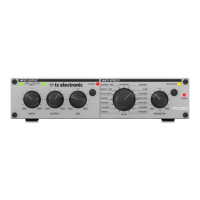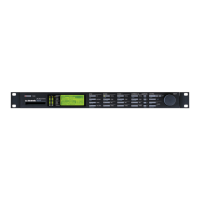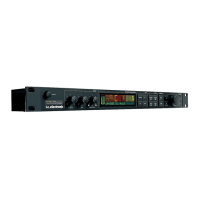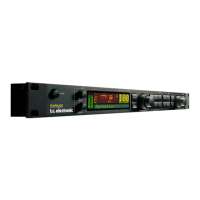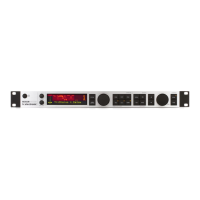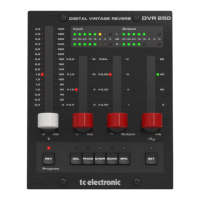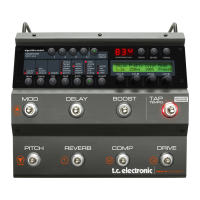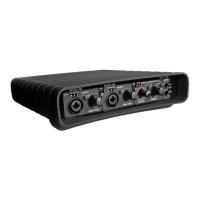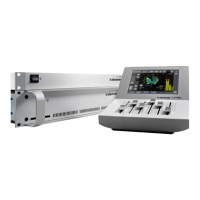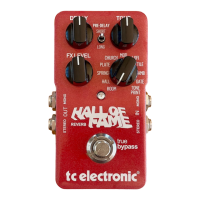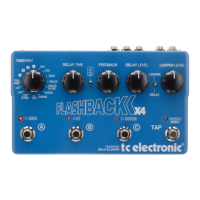Do you have a question about the TC Electronic Konnekt 24D and is the answer not in the manual?
To reduce the risk of fire or electrical shock, do not expose this equipment to dripping or splashing.
Any change or modifications not expressly approved may void your authority to operate this equipment.
Equipment tested for Class B Digital device compliance with FCC rules against harmful interference.
Declaration that the product conforms to specified safety and emission standards.
Information on finding answers and upgrades for Cubase LE.
Steps for unpacking, checking contents, and system requirements for setup.
Instructions for installing software and accessing the TC Near control panel.
Guide for setting up Konnekt with Cubase LE.
Steps for installing Cubase and selecting Konnekt as the audio interface.
Creating projects and understanding ASIO channel names.
Step-by-step guide for setting up Fabrik R as a send effect in Cubase.
Guide for setting up Fabrik C as an insert effect in Cubase.
Explanation of the FireWire/Power LED and Mic/Inst combo XLR/Jack inputs.
Details on Pad/Inst selectors and the 1/4" jack connection.
Description of input LEDs and the Gain/Trim control.
Information on phantom power and different microphone requirements.
How to use the Line In switch and Source Level knob.
Explanation of monitor LEDs and the channel select button.
Details on channels 3/4, DI input, and User monitoring options.
Controls for output level, DSP presets, and headphone muting.
Information on the AUX input and its function for Konnekt 8.
Explanation of the power switch and power input options.
Details on FireWire connections and MIDI ports.
Description of S/PDIF, ADAT, and line output connectors.
Details on balanced line inputs and digital I/O options.
Highlights differences in the front panel compared to Konnekt 24D.
Details omitted features on the Konnekt 8 rear panel compared to 24D.
Description of the rear panel and active speaker connection.
How to connect a keyboard, headphones, and the computer.
Connecting an ADAT interface and instruments to the front panel.
Details on FireWire connectivity and power supply options.
Explanation of a typical mobile setup with a guitar, mic, and laptop.
How Konnekt integrates in a live setup with DAW, headphones, and PA system.
Benefits of routing different signals for DJs and cue monitoring.
Using Konnekt without a computer for mic pre-amps and effects.
Shows how to hook up multiple Konnekt units via FireWire.
Overview of mixer page tabs, input section, and level meters.
Explanation of send knobs for effects and pan/balance controls.
Controls for output level, direct monitoring, and DSP preset management.
Details on input meters, clip indication, and Fabrik C activation.
Functionality of Send knobs, Pan control, and Out Level fader.
How to assign the light ring and configure digital channels.
Managing DAW main outputs and monitoring within the mixer.
Controls for Fabrik R return level and monitor mixer output.
How to load and save presets using the File menu.
Configuring analog inputs, monitor view, and light ring assignment.
Setting up output routing and configuring digital inputs.
Configuring linked devices and standalone clock settings.
Auto-sensing inputs, PAD/INST, and stereo linking for channels 1/2 & 3/4.
Configuring digital inputs and understanding lock status.
Selecting digital input formats like ADAT and S/PDIF.
Options for displaying digital channels in the mixer view.
Assigning monitor mix and configuring linked devices.
Setting up signal routing to outputs and selecting sources.
Details on configuring optical outputs for ADAT and S/PDIF.
Selecting the sync source for standalone operation.
Setting the sample rate for standalone operation.
Step-by-step guide to configure WDM driver in Windows for audio.
Adjusting buffer size and understanding latency.
Managing system clock master, sync source, and sample rate.
Information on control panel and FireWire driver versions.
How to adjust buffer size for performance.
Understanding clock master selection and sync source options.
Setting the sample rate and its relation to host application.
Interpreting internal and external lock status indicators.
Procedures for checking and updating the unit's firmware.
How to perform a factory reset on the Konnekt unit.
Key features of the Fabrik C channel strip plug-in.
Selecting routing modes (Plug-in vs. Internal) for Fabrik C.
Discusses full-band vs. 3-band compression and application scenarios.
Using 3-band and full-band compression for various sources.
Details on the Limiter, 4-band EQ, and De-Esser functions.
Schematic overview of signal flow in Fabrik C.
Explanation of EQ filter types, adjustment, and bypass.
Visual representation of Parametric, Shelving, Notch, and Cut filter types.
How to adjust bandwidth/type and frequency/gain for EQ bands.
Selecting source material and adjusting input/output gain.
Adjusting compression amount and level compensation for bands.
Adjusting compression parameters and using grid/compass features.
Settings for the Limiter threshold and De-Esser amount.
Options for routing Fabrik C (Plug-in vs. Internal) and 96kHz limitations.
Key features of the Fabrik R reverb plug-in.
Selecting routing modes (Plug-in vs. Internal) for Fabrik R.
Description and application of Live and Hall reverb types.
Description and application of Plate and Club reverb types.
How to adjust parameters in the Tweak section.
Adjusting modulation depth and rate for reverb.
Adjusting LoColor, HiColor, and HiFactor for reverb.
Adjusting Dry, Early, and Reverb levels.
Bypass, In/Out levels, Meters, and Kill Dry/Wet functions.
Setting routing options for Fabrik R.
Installing the plugin and selecting device/channel.
Verifying connections and calibrating latency.
Overview of the tuner page, note indication, and LEDs.
Switching between Strobe/normal modes and assigning lightring display.
Using play tone, setting pitch, muting, and selecting scale modes.
To reduce the risk of fire or electrical shock, do not expose this equipment to dripping or splashing.
Any change or modifications not expressly approved may void your authority to operate this equipment.
Equipment tested for Class B Digital device compliance with FCC rules against harmful interference.
Declaration that the product conforms to specified safety and emission standards.
Information on finding answers and upgrades for Cubase LE.
Steps for unpacking, checking contents, and system requirements for setup.
Instructions for installing software and accessing the TC Near control panel.
Guide for setting up Konnekt with Cubase LE.
Steps for installing Cubase and selecting Konnekt as the audio interface.
Creating projects and understanding ASIO channel names.
Step-by-step guide for setting up Fabrik R as a send effect in Cubase.
Guide for setting up Fabrik C as an insert effect in Cubase.
Explanation of the FireWire/Power LED and Mic/Inst combo XLR/Jack inputs.
Details on Pad/Inst selectors and the 1/4" jack connection.
Description of input LEDs and the Gain/Trim control.
Information on phantom power and different microphone requirements.
How to use the Line In switch and Source Level knob.
Explanation of monitor LEDs and the channel select button.
Details on channels 3/4, DI input, and User monitoring options.
Controls for output level, DSP presets, and headphone muting.
Information on the AUX input and its function for Konnekt 8.
Explanation of the power switch and power input options.
Details on FireWire connections and MIDI ports.
Description of S/PDIF, ADAT, and line output connectors.
Details on balanced line inputs and digital I/O options.
Highlights differences in the front panel compared to Konnekt 24D.
Details omitted features on the Konnekt 8 rear panel compared to 24D.
Description of the rear panel and active speaker connection.
How to connect a keyboard, headphones, and the computer.
Connecting an ADAT interface and instruments to the front panel.
Details on FireWire connectivity and power supply options.
Explanation of a typical mobile setup with a guitar, mic, and laptop.
How Konnekt integrates in a live setup with DAW, headphones, and PA system.
Benefits of routing different signals for DJs and cue monitoring.
Using Konnekt without a computer for mic pre-amps and effects.
Shows how to hook up multiple Konnekt units via FireWire.
Overview of mixer page tabs, input section, and level meters.
Explanation of send knobs for effects and pan/balance controls.
Controls for output level, direct monitoring, and DSP preset management.
Details on input meters, clip indication, and Fabrik C activation.
Functionality of Send knobs, Pan control, and Out Level fader.
How to assign the light ring and configure digital channels.
Managing DAW main outputs and monitoring within the mixer.
Controls for Fabrik R return level and monitor mixer output.
How to load and save presets using the File menu.
Configuring analog inputs, monitor view, and light ring assignment.
Setting up output routing and configuring digital inputs.
Configuring linked devices and standalone clock settings.
Auto-sensing inputs, PAD/INST, and stereo linking for channels 1/2 & 3/4.
Configuring digital inputs and understanding lock status.
Selecting digital input formats like ADAT and S/PDIF.
Options for displaying digital channels in the mixer view.
Assigning monitor mix and configuring linked devices.
Setting up signal routing to outputs and selecting sources.
Details on configuring optical outputs for ADAT and S/PDIF.
Selecting the sync source for standalone operation.
Setting the sample rate for standalone operation.
Step-by-step guide to configure WDM driver in Windows for audio.
Adjusting buffer size and understanding latency.
Managing system clock master, sync source, and sample rate.
Information on control panel and FireWire driver versions.
How to adjust buffer size for performance.
Understanding clock master selection and sync source options.
Setting the sample rate and its relation to host application.
Interpreting internal and external lock status indicators.
Procedures for checking and updating the unit's firmware.
How to perform a factory reset on the Konnekt unit.
Key features of the Fabrik C channel strip plug-in.
Selecting routing modes (Plug-in vs. Internal) for Fabrik C.
Discusses full-band vs. 3-band compression and application scenarios.
Using 3-band and full-band compression for various sources.
Details on the Limiter, 4-band EQ, and De-Esser functions.
Schematic overview of signal flow in Fabrik C.
Explanation of EQ filter types, adjustment, and bypass.
Visual representation of Parametric, Shelving, Notch, and Cut filter types.
How to adjust bandwidth/type and frequency/gain for EQ bands.
Selecting source material and adjusting input/output gain.
Adjusting compression amount and level compensation for bands.
Adjusting compression parameters and using grid/compass features.
Settings for the Limiter threshold and De-Esser amount.
Options for routing Fabrik C (Plug-in vs. Internal) and 96kHz limitations.
Key features of the Fabrik R reverb plug-in.
Selecting routing modes (Plug-in vs. Internal) for Fabrik R.
Description and application of Live and Hall reverb types.
Description and application of Plate and Club reverb types.
How to adjust parameters in the Tweak section.
Adjusting modulation depth and rate for reverb.
Adjusting LoColor, HiColor, and HiFactor for reverb.
Adjusting Dry, Early, and Reverb levels.
Bypass, In/Out levels, Meters, and Kill Dry/Wet functions.
Setting routing options for Fabrik R.
Installing the plugin and selecting device/channel.
Verifying connections and calibrating latency.
Overview of the tuner page, note indication, and LEDs.
Switching between Strobe/normal modes and assigning lightring display.
Using play tone, setting pitch, muting, and selecting scale modes.
| Type | Audio Interface |
|---|---|
| Connectivity | FireWire |
| A/D Resolution | 24-bit/96kHz |
| Microphone Preamps | 2 |
| Phantom Power | Yes |
| Headphone Output | 1 |
| Built-in DSP | Yes |
| Driver | ASIO, Core Audio |
| Simultaneous I/O | 24 |
| Analog Inputs | 4 |
| Digital Inputs | S/PDIF, ADAT |
| Digital Outputs | S/PDIF, ADAT |
| MIDI I/O | Yes |
| Software Included | TC Near |

